Handling Dry Nanoparticles
The ‘Composites and Plastics Lab’ is maintained by Dr. Jitendra Tate.This lab uses different types of industrial nanoparticles such as nanoclays and Halloysite Nanotubes (HNT); and engineered nanoparticles such as multiwall carbon nanotubes (MWCNT). These dry nanoparticles are dispersed with liquid thermoset resins using different mixing techniques such as high shear mixer, sonication, centrifugal mixer, and low-shear mechanical mixer. These nanomodified resins are further used in composite manufacturing processes such as vacuum infusion and compression molding.
Special care is taken while handling and storing dry nanoparticles. Handling dry nanoparticles in an open atmosphere is not allowed. Two methods have been developed to handle dry nanoclays and dry carbon nanotubes.
Specialized Glove Box for Nanoclays
Dry nanoclays are stored and handled in a specialized glove box. The experimenter has to mix dry nanoparticles in the liquid polymer resin or solvent inside the glove box and only then should transfer to other equipment such as high shear mixer or, centrifugal mixer. The high shear mixer is kept under a fume hood at all times. There is a definite protocol to be followed based on the material system.
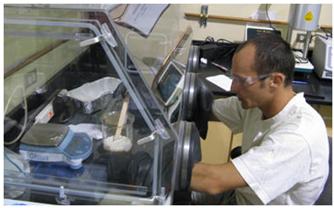
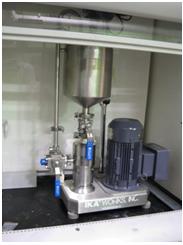
Specialized Glove Box to Handle Dry Nanoclays High Shear Mixer
Specialized Nanoparticle Containment Room for Carbon Nanotubes and Related Materials
Handling of dry carbon nanotubes imposes certain health hazards. We do not allow the use of carbon nanotubes in the glove box. These classes of materials should be isolated from other parts of the lab. Therefore, we ordered a portable clean room referred to as the nanoparticle containment room. This room is designed and manufactured (as per our requirements) by Liberty Industries, Inc. Berlin, Conn. 06023. This room has been installed in one small room within the lab.
The following are the highlights of the nanoparticle containment room:
- An 8’ x 10’ hard-wall ready-made clean room
- Maintains negative pressure and there is dedicated exhaust to this room (with blower on the roof).
- Uses ULPA (Ultra-Low Penetration Air) Filters rated 99.999 percent efficient with particles 0.12 microns (120 nm) in diameter. Traditional HEPA filters are good up to 0.3 microns (300 nm) with rated efficiency of 99.98percent.
- Researchers using this room have to wear half-mask respirator, lab suit; and other personal protected equipment (PPE)
- Anyone using the room must pass pulmonary function test and undergo respirator training.
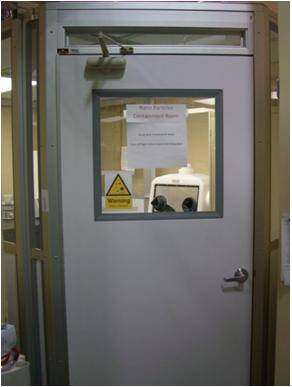
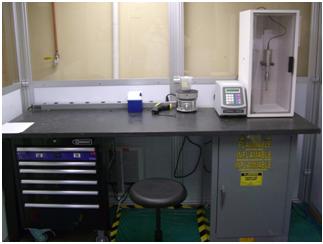
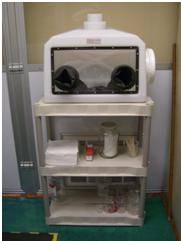
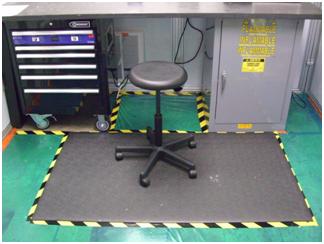
Nanoparticle Containment Room
Safety Training on Mechanical Tooling and Hazardous Materials
All faculty, staff; and students using these labs must undergo safety training provided by Mr. Ray Cook, chief technician, Ingram School of Engineering and Ms. Elsie Romano, Industrial Hygiene, Environmental Health Safety & Risk Management (EHS&RM) in the areas of mechanical tooling, hazardous communication, hazardous waste disposal’, and respiratory protection. All students must pass a quiz in these areas before using the facilities. All labs involving hazards materials and safety concerns are inspected monthly by RM. Deficiencies are reported to the lab manager and head of the department. In case these deficiencies are not addressed on time, the use of some equipment or the entire lab is not allowed.
Half-mask Respirators and ‘Pulmonary Function Test (PFT)’
Experimenters must use half-mask respirators and the appropiate filters while handling dry nanoparticles. A use of filter log is maintained. A filter is not used longer than its specified life, usually eight hours. EHS&RM offers special training on the use of respirators. All faculty, staff; and students using respirators have to take a pulmonary function test (PFT) at the Department of Respiratory Care with Dr. Greg Marshall. Anyone who does not pass the test is not allowed to use the respirators and not allowed to experiment with dry nanoparticles.